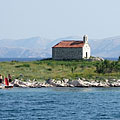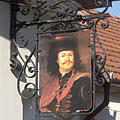(Optimalisert for enheter med liten skjerm)
Józsefváros, Keleti Railway Station - Budapest, Ungarn
Når du klikker:
Klikk på bildene!
-

The Keleti Train Station with the half covered modern pedestrian subway system
Dato for fotografering: 10.06.20142014
Laget av: Robert Németh
Kameramodell: Konica Minolta Dimage A200
Budapest, Ungarn
-

The new subway and the Keleti Railway Station
Dato for fotografering: 10.06.20142014
Laget av: Robert Németh
Kameramodell: Konica Minolta Dimage A200
Budapest, Ungarn
-
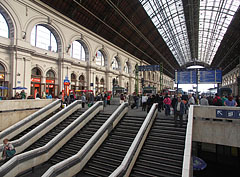
Wide stairs in the platform hall (or Great Hall)
Dato for fotografering: 20.09.20132013
Laget av: Robert Németh
Kameramodell: Konica Minolta Dimage A200
Budapest, Ungarn
-
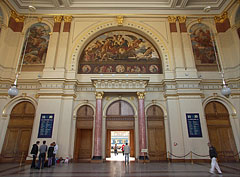
The decorated waiting hall of the Keleti Railway Station (the so-called Lotz Hall)
Dato for fotografering: 20.09.20132013
Laget av: Robert Németh
Kameramodell: Konica Minolta Dimage A200
Budapest, Ungarn
-
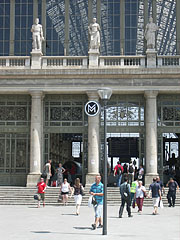
The main entrance of the Keleti Railway Station
Dato for fotografering: 10.06.20142014
Laget av: Robert Németh
Kameramodell: Konica Minolta Dimage A200
Budapest, Ungarn
-
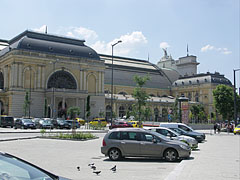
Parking lot and the north side of the Keleti Train Terminal building
Dato for fotografering: 10.06.20142014
Laget av: Robert Németh
Kameramodell: Konica Minolta Dimage A200
Budapest, Ungarn
-

The north entrance of the Keleti Train Station, the departure lounge and ornate waiting hall from outside
Dato for fotografering: 10.06.20142014
Laget av: Robert Németh
Kameramodell: Konica Minolta Dimage A200
Budapest, Ungarn
-
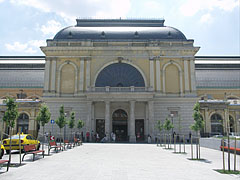
The ornate departure hall of the Keleti Railroad Station from outside
Dato for fotografering: 10.06.20142014
Laget av: Robert Németh
Kameramodell: Konica Minolta Dimage A200
Budapest, Ungarn
-
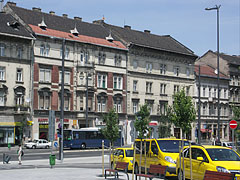
Four-story residental buildings and yellow taxies in the north side of the Baross Square
Dato for fotografering: 10.06.20142014
Laget av: Robert Németh
Kameramodell: Konica Minolta Dimage A200
Budapest, Ungarn
-

Taxi stand and small park in the north part of the Baross Square, near the Keleti Railway Station
Dato for fotografering: 10.06.20142014
Laget av: Robert Németh
Kameramodell: Konica Minolta Dimage A200
Budapest, Ungarn
-
The main post office at the Keleti Train Terminal
Dato for fotografering: 10.06.20142014
Laget av: Robert Németh
Kameramodell: Konica Minolta Dimage A200
Budapest, Ungarn
The main post office at the Keleti Train Terminal - Budapest, Ungarn -
The nort side of the Keleti Train Terminal
Dato for fotografering: 10.06.20142014
Laget av: Robert Németh
Kameramodell: Konica Minolta Dimage A200
Budapest, Ungarn
The nort side of the Keleti Train Terminal - Budapest, Ungarn -
The "Agriculture" wall painting in the Lotz Hall
Created by Károly Lotz Hungarian painter in 1884.
Dato for fotografering: 10.06.20142014
Laget av: Robert Németh
Kameramodell: Konica Minolta Dimage A200
Budapest, Ungarn
The "Agriculture" wall painting in the Lotz Hall - Budapest, Ungarn -
The Lotz Hall of the railway station
Dato for fotografering: 10.06.20142014
Laget av: Robert Németh
Kameramodell: Konica Minolta Dimage A200
Budapest, Ungarn
The Lotz Hall of the railway station - Budapest, Ungarn -
Lotz Hall in the train station
Dato for fotografering: 10.06.20142014
Laget av: Robert Németh
Kameramodell: Konica Minolta Dimage A200
Budapest, Ungarn
Lotz Hall in the train station - Budapest, Ungarn -
The Lotz Hall is the former departure hall
The titles of the murals: "Bridge construction" and "Post", artworks of Károly Lotz from 1884.
Dato for fotografering: 10.06.20142014
Laget av: Robert Németh
Kameramodell: Konica Minolta Dimage A200
Budapest, Ungarn
The Lotz Hall is the former departure hall - Budapest, Ungarn -
The "Trade" allegorical wall painting in the Lotz Hall
Created by Károly Lotz Hungarian painter in 1884.
Dato for fotografering: 10.06.20142014
Laget av: Robert Németh
Kameramodell: Konica Minolta Dimage A200
Budapest, Ungarn
The "Trade" allegorical wall painting in the Lotz Hall - Budapest, Ungarn -
The ornate Lotz Hall
Dato for fotografering: 10.06.20142014
Laget av: Robert Németh
Kameramodell: Konica Minolta Dimage A200
Budapest, Ungarn
The ornate Lotz Hall - Budapest, Ungarn -
The interior of the main hall, also known as train shed or overall roof in the Keleti Railway Station
The dimensions of the hall: 188 meters in length, 44 meters in width and 31.5 meters in height.
Dato for fotografering: 10.06.20142014
Laget av: Robert Németh
Kameramodell: Konica Minolta Dimage A200
Budapest, Ungarn
The interior of the main hall, also known as train shed or overall roof in the Keleti Railway Station - Budapest, Ungarn -
The view of the square from the main entrance of the Keleti Train Terminal
Dato for fotografering: 10.06.20142014
Laget av: Robert Németh
Kameramodell: Konica Minolta Dimage A200
Budapest, Ungarn
The view of the square from the main entrance of the Keleti Train Terminal - Budapest, Ungarn -
Stairs at the main entrance of the Keleti Railway station
Dato for fotografering: 10.06.20142014
Laget av: Robert Németh
Kameramodell: Konica Minolta Dimage A200
Budapest, Ungarn
Stairs at the main entrance of the Keleti Railway station - Budapest, Ungarn -
A renovated old residental building on the Baross Square, viewed from the stairs of the Keleti Train Station
Dato for fotografering: 10.06.20142014
Laget av: Robert Németh
Kameramodell: Konica Minolta Dimage A200
Budapest, Ungarn
A renovated old residental building on the Baross Square, viewed from the stairs of the Keleti Train Station - Budapest, Ungarn -
The main hall of the Keleti Railway Station
Dato for fotografering: 10.06.20142014
Laget av: Robert Németh
Kameramodell: Konica Minolta Dimage A200
Budapest, Ungarn
The main hall of the Keleti Railway Station - Budapest, Ungarn -
Baross Square
Dato for fotografering: 10.06.20142014
Laget av: Robert Németh
Kameramodell: Konica Minolta Dimage A200
Budapest, Ungarn
Baross Square - Budapest, Ungarn -
The new pedestrian subway system in Baross Square
Dato for fotografering: 10.06.20142014
Laget av: Robert Németh
Kameramodell: Konica Minolta Dimage A200
Budapest, Ungarn
The new pedestrian subway system in Baross Square - Budapest, Ungarn -
The secession style 4-star Golden Park Hotel from the subway
The hotel was built in 1918, in World War II it was seriously damaged, then it was reconstructed in 1959.
Dato for fotografering: 10.06.20142014
Laget av: Robert Németh
Kameramodell: Konica Minolta Dimage A200
Budapest, Ungarn
The secession style 4-star Golden Park Hotel from the subway - Budapest, Ungarn -
Stone sculpture group on the top of the Keletio Railway Station
Dato for fotografering: 10.06.20142014
Laget av: Robert Németh
Kameramodell: Konica Minolta Dimage A200
Budapest, Ungarn
Stone sculpture group on the top of the Keletio Railway Station - Budapest, Ungarn -
Statue of James Watt (1736-1819) Scottish engineer, inventor of the steam-engine on the facade of the Keleti Railway Station
The statue is standing in the right side big niche, created by Alajos Stróbl in 1884.
Dato for fotografering: 10.06.20142014
Laget av: Robert Németh
Kameramodell: Konica Minolta Dimage A200
Budapest, Ungarn
Statue of James Watt (1736-1819) Scottish engineer, inventor of the steam-engine on the facade of the Keleti Railway Station - Budapest, Ungarn -
Looking to the Keleti Railway Terminal building from the wide stairs of the pedestrian subway
Dato for fotografering: 10.06.20142014
Laget av: Robert Németh
Kameramodell: Konica Minolta Dimage A200
Budapest, Ungarn
Looking to the Keleti Railway Terminal building from the wide stairs of the pedestrian subway - Budapest, Ungarn -
Pedestrian underpass (or subway)
Dato for fotografering: 10.06.20142014
Laget av: Robert Németh
Kameramodell: Konica Minolta Dimage A200
Budapest, Ungarn
Pedestrian underpass (or subway) - Budapest, Ungarn -
Two residental buildings on the Baross Square (one is a hotel, the other is a fastfood restaurant)
Dato for fotografering: 10.06.20142014
Laget av: Robert Németh
Kameramodell: Konica Minolta Dimage A200
Budapest, Ungarn
Two residental buildings on the Baross Square (one is a hotel, the other is a fastfood restaurant) - Budapest, Ungarn -
Half-open pedestrian subway system in the middle of the Baross Square
Dato for fotografering: 10.06.20142014
Laget av: Robert Németh
Kameramodell: Konica Minolta Dimage A200
Budapest, Ungarn
Half-open pedestrian subway system in the middle of the Baross Square - Budapest, Ungarn -
Keleti Railway Terminal (Hungarian word "keleti" means "eastern")
Dato for fotografering: 10.06.20142014
Laget av: Robert Németh
Kameramodell: Konica Minolta Dimage A200
Budapest, Ungarn
Keleti Railway Terminal (Hungarian word "keleti" means "eastern") - Budapest, Ungarn -
Renewed pedestrian subway under the square
Dato for fotografering: 10.06.20142014
Laget av: Robert Németh
Kameramodell: Konica Minolta Dimage A200
Budapest, Ungarn
Renewed pedestrian subway under the square - Budapest, Ungarn -
Pedestrial subway system in Baross Square
Dato for fotografering: 10.06.20142014
Laget av: Robert Németh
Kameramodell: Konica Minolta Dimage A200
Budapest, Ungarn
Pedestrial subway system in Baross Square - Budapest, Ungarn -
The main facade of the eclectic style impressive Keleti Train Station
It was built in 1884, the building was designed by Gyula Rochlitz and the main hall by János Feketeházy.
Dato for fotografering: 10.06.20142014
Laget av: Robert Németh
Kameramodell: Konica Minolta Dimage A200
Budapest, Ungarn
The main facade of the eclectic style impressive Keleti Train Station - Budapest, Ungarn -
Statue of George Stephenson (1781-1848) English engineer on the main wall of the Keleti Railway Station
The statue is standing in the left side large sculpture niche, created by Ferenc Vasadi Ferenc in 1884.
Dato for fotografering: 10.06.20142014
Laget av: Robert Németh
Kameramodell: Konica Minolta Dimage A200
Budapest, Ungarn
Statue of George Stephenson (1781-1848) English engineer on the main wall of the Keleti Railway Station - Budapest, Ungarn -
The main hall of the Keleti Train Terminal from outside, on the facade there is the characteristic large semicircular glass wall
Dato for fotografering: 10.06.20142014
Laget av: Robert Németh
Kameramodell: Konica Minolta Dimage A200
Budapest, Ungarn
The main hall of the Keleti Train Terminal from outside, on the facade there is the characteristic large semicircular glass wall - Budapest, Ungarn -
The outer central clock of the Keleti Railway Terminal
Dato for fotografering: 10.06.20142014
Laget av: Robert Németh
Kameramodell: Konica Minolta Dimage A200
Budapest, Ungarn
The outer central clock of the Keleti Railway Terminal - Budapest, Ungarn -
Details of the Baross Square at the Keleti Train Station
Dato for fotografering: 10.06.20142014
Laget av: Robert Németh
Kameramodell: Konica Minolta Dimage A200
Budapest, Ungarn
Details of the Baross Square at the Keleti Train Station - Budapest, Ungarn -
The main building of the Keleti Railway Station
Dato for fotografering: 10.06.20142014
Laget av: Robert Németh
Kameramodell: Konica Minolta Dimage A200
Budapest, Ungarn
The main building of the Keleti Railway Station - Budapest, Ungarn -
Keleti Railway Station (or Keleti Railroad Station, Keleti Train Terminal, in Hungarian: "Keleti pályaudvar")
Dato for fotografering: 10.06.20142014
Laget av: Robert Németh
Kameramodell: Konica Minolta Dimage A200
Budapest, Ungarn
Keleti Railway Station (or Keleti Railroad Station, Keleti Train Terminal, in Hungarian: "Keleti pályaudvar") - Budapest, Ungarn -
Spacious half covered renovated pedestrian subway system
Dato for fotografering: 10.06.20142014
Laget av: Robert Németh
Kameramodell: Konica Minolta Dimage A200
Budapest, Ungarn
Spacious half covered renovated pedestrian subway system - Budapest, Ungarn -
The Keleti Reilway Station building viewed from pedestrian underpass stairs in the middle of the square, that is recessed under the street level
Dato for fotografering: 10.06.20142014
Laget av: Robert Németh
Kameramodell: Konica Minolta Dimage A200
Budapest, Ungarn
The Keleti Reilway Station building viewed from pedestrian underpass stairs in the middle of the square, that is recessed under the street level - Budapest, Ungarn -
One of the stairs of the pedestrian subway, as well as the Keleti Railway Station
Dato for fotografering: 10.06.20142014
Laget av: Robert Németh
Kameramodell: Konica Minolta Dimage A200
Budapest, Ungarn
One of the stairs of the pedestrian subway, as well as the Keleti Railway Station - Budapest, Ungarn -
The modern, spacious and sunny subway in front of the Keleti Train Station is built in place of an older pedestrian underpass, which was rundown after the many decades
But of course when it was constructed in 1968, the former pedestrian subway system was also quite advanced.
Dato for fotografering: 10.06.20142014
Laget av: Robert Németh
Kameramodell: Konica Minolta Dimage A200
Budapest, Ungarn
The modern, spacious and sunny subway in front of the Keleti Train Station is built in place of an older pedestrian underpass, which was rundown after the many decades - Budapest, Ungarn -
The renovated and modern subway system in the middle of the square in front of the Keleti Railway Station
Or in different point of view, the square itself is recessed under the street floor.
Dato for fotografering: 10.06.20142014
Laget av: Robert Németh
Kameramodell: Konica Minolta Dimage A200
Budapest, Ungarn
The renovated and modern subway system in the middle of the square in front of the Keleti Railway Station - Budapest, Ungarn -
Looking to the main facade of the Keleti Train Terminal from the pedestrian subway
Dato for fotografering: 10.06.20142014
Laget av: Robert Németh
Kameramodell: Konica Minolta Dimage A200
Budapest, Ungarn
Looking to the main facade of the Keleti Train Terminal from the pedestrian subway - Budapest, Ungarn -
Krokodil Corso shoe store downstairs in the seven-story residental building
Dato for fotografering: 10.06.20142014
Laget av: Robert Németh
Kameramodell: Konica Minolta Dimage A200
Budapest, Ungarn
Krokodil Corso shoe store downstairs in the seven-story residental building - Budapest, Ungarn -
An entrance of the pedestrian subway with the Gábor Baross statue beside it, and the Keleti Train Station in the background
Dato for fotografering: 10.06.20142014
Laget av: Robert Németh
Kameramodell: Konica Minolta Dimage A200
Budapest, Ungarn
An entrance of the pedestrian subway with the Gábor Baross statue beside it, and the Keleti Train Station in the background - Budapest, Ungarn -
Gábor Baross sculpture group
Created by Antal Szécsi in 1898
Dato for fotografering: 10.06.20142014
Laget av: Robert Németh
Kameramodell: Konica Minolta Dimage A200
Budapest, Ungarn
Gábor Baross sculpture group - Budapest, Ungarn -
Bronze statur group of Gábor Baross (1848-1892) famous Hungarian politician, in his time often called the "iron minister"
Dato for fotografering: 10.06.20142014
Laget av: Robert Németh
Kameramodell: Konica Minolta Dimage A200
Budapest, Ungarn
Bronze statur group of Gábor Baross (1848-1892) famous Hungarian politician, in his time often called the "iron minister" - Budapest, Ungarn -
The renovated Baross Square with the overpass (or in other word flyover)
Dato for fotografering: 10.06.20142014
Laget av: Robert Németh
Kameramodell: Konica Minolta Dimage A200
Budapest, Ungarn
The renovated Baross Square with the overpass (or in other word flyover) - Budapest, Ungarn -
The Keleti Train Station and the Gábor Baross statue, the latter stands now almost at its original position again since the renovation of the square in 2013
Dato for fotografering: 10.06.20142014
Laget av: Robert Németh
Kameramodell: Konica Minolta Dimage A200
Budapest, Ungarn
The Keleti Train Station and the Gábor Baross statue, the latter stands now almost at its original position again since the renovation of the square in 2013 - Budapest, Ungarn -
Bronze laurel wreath on the Gábor Baross statue group, above it there is the allegorical male figure of the industry
Dato for fotografering: 10.06.20142014
Laget av: Robert Németh
Kameramodell: Konica Minolta Dimage A200
Budapest, Ungarn
Bronze laurel wreath on the Gábor Baross statue group, above it there is the allegorical male figure of the industry - Budapest, Ungarn -
Bronze male figure, the allegorical character of the transport
Dato for fotografering: 10.06.20142014
Laget av: Robert Németh
Kameramodell: Konica Minolta Dimage A200
Budapest, Ungarn
Bronze male figure, the allegorical character of the transport - Budapest, Ungarn -
Lying male figure and a steam locomotive on the Gábor Baross sculpture group (this symbolizes the connection between the statesman and the railway)
Dato for fotografering: 10.06.20142014
Laget av: Robert Németh
Kameramodell: Konica Minolta Dimage A200
Budapest, Ungarn
Lying male figure and a steam locomotive on the Gábor Baross sculpture group (this symbolizes the connection between the statesman and the railway) - Budapest, Ungarn -
Four-storey old apartment house on the Erzsébetváros side of the square
Dato for fotografering: 10.06.20142014
Laget av: Robert Németh
Kameramodell: Konica Minolta Dimage A200
Budapest, Ungarn
Four-storey old apartment house on the Erzsébetváros side of the square - Budapest, Ungarn -
The little bit rusty manhole cover of the Sewage Works Company
Dato for fotografering: 10.06.20142014
Laget av: Robert Németh
Kameramodell: Konica Minolta Dimage A200
Budapest, Ungarn
The little bit rusty manhole cover of the Sewage Works Company - Budapest, Ungarn -
Budapest Keleti Railway Station (in Hungarian: "Keleti pályaudvar")
Dato for fotografering: 10.06.20142014
Laget av: Robert Németh
Kameramodell: Konica Minolta Dimage A200
Budapest, Ungarn
Budapest Keleti Railway Station (in Hungarian: "Keleti pályaudvar") - Budapest, Ungarn -
The Keleti Railway Station and the new pedestrian subway
Dato for fotografering: 10.06.20142014
Laget av: Robert Németh
Kameramodell: Konica Minolta Dimage A200
Budapest, Ungarn
The Keleti Railway Station and the new pedestrian subway - Budapest, Ungarn -
The 3-star Hotel Baross is in an Art Nouveau style apartment house
Built in 1907, architect: Albert Kőrössy
Dato for fotografering: 10.06.20142014
Laget av: Robert Németh
Kameramodell: Konica Minolta Dimage A200
Budapest, Ungarn
The 3-star Hotel Baross is in an Art Nouveau style apartment house - Budapest, Ungarn -
Bus stop on the north side of the square, and the Keleti Train Station
Dato for fotografering: 10.06.20142014
Laget av: Robert Németh
Kameramodell: Konica Minolta Dimage A200
Budapest, Ungarn
Bus stop on the north side of the square, and the Keleti Train Station - Budapest, Ungarn -
The stop of the city bus line 112 at the Keleti Railway Terminal
Dato for fotografering: 10.06.20142014
Laget av: Robert Németh
Kameramodell: Konica Minolta Dimage A200
Budapest, Ungarn
The stop of the city bus line 112 at the Keleti Railway Terminal - Budapest, Ungarn -
Golden Park Hotel
Dato for fotografering: 10.06.20142014
Laget av: Robert Németh
Kameramodell: Konica Minolta Dimage A200
Budapest, Ungarn
Golden Park Hotel - Budapest, Ungarn -
Baross Square with the Golden Park Hotel in the background
Dato for fotografering: 10.06.20142014
Laget av: Robert Németh
Kameramodell: Konica Minolta Dimage A200
Budapest, Ungarn
Baross Square with the Golden Park Hotel in the background - Budapest, Ungarn -
Baross Square underpass
Dato for fotografering: 10.06.20142014
Laget av: Robert Németh
Kameramodell: Konica Minolta Dimage A200
Budapest, Ungarn
Baross Square underpass - Budapest, Ungarn -
Keleti Railway Terminal
Dato for fotografering: 10.06.20142014
Laget av: Robert Németh
Kameramodell: Konica Minolta Dimage A200
Budapest, Ungarn
Keleti Railway Terminal - Budapest, Ungarn -
The main facade of the Keleti Railway Station
Dato for fotografering: 10.06.20142014
Laget av: Robert Németh
Kameramodell: Konica Minolta Dimage A200
Budapest, Ungarn
The main facade of the Keleti Railway Station - Budapest, Ungarn -
Four allegorical figures in the statue on the top of the Keleti Railway Station, above the main entrance
Dato for fotografering: 10.06.20142014
Laget av: Robert Németh
Kameramodell: Konica Minolta Dimage A200
Budapest, Ungarn
Four allegorical figures in the statue on the top of the Keleti Railway Station, above the main entrance - Budapest, Ungarn -
The central clock of the Keleti Train Station on the outer wall
Dato for fotografering: 10.06.20142014
Laget av: Robert Németh
Kameramodell: Konica Minolta Dimage A200
Budapest, Ungarn
The central clock of the Keleti Train Station on the outer wall - Budapest, Ungarn -
The top of the Keleti Train Terminal building with the characteristic sculpture called "The allegory of the transport"
Created by Gyula Bezerédi Gyula in 1884
Dato for fotografering: 10.06.20142014
Laget av: Robert Németh
Kameramodell: Konica Minolta Dimage A200
Budapest, Ungarn
The top of the Keleti Train Terminal building with the characteristic sculpture called "The allegory of the transport" - Budapest, Ungarn -
The allegorical statue on the top of the facade of the Keleti Railway Station
Dato for fotografering: 10.06.20142014
Laget av: Robert Németh
Kameramodell: Konica Minolta Dimage A200
Budapest, Ungarn
The allegorical statue on the top of the facade of the Keleti Railway Station - Budapest, Ungarn -
The entrance of the Keleti Train Station on the main wall
Dato for fotografering: 10.06.20142014
Laget av: Robert Németh
Kameramodell: Konica Minolta Dimage A200
Budapest, Ungarn
The entrance of the Keleti Train Station on the main wall - Budapest, Ungarn -
The renovated underpass of the Baross Square
Dato for fotografering: 10.06.20142014
Laget av: Robert Németh
Kameramodell: Konica Minolta Dimage A200
Budapest, Ungarn
The renovated underpass of the Baross Square - Budapest, Ungarn -
The renovated pedestrian subway in the Baross Square
Dato for fotografering: 10.06.20142014
Laget av: Robert Németh
Kameramodell: Konica Minolta Dimage A200
Budapest, Ungarn
The renovated pedestrian subway in the Baross Square - Budapest, Ungarn -
M4 (green) metro line, the way down with the elevators to the "Keleti pályaudvar" station
Dato for fotografering: 10.06.20142014
Laget av: Robert Németh
Kameramodell: Konica Minolta Dimage A200
Budapest, Ungarn
M4 (green) metro line, the way down with the elevators to the "Keleti pályaudvar" station - Budapest, Ungarn -
M4 (green) metro line, "Keleti pályaudvar" (Keleti train Terminal) station, way down to the platforms
Dato for fotografering: 10.06.20142014
Laget av: Robert Németh
Kameramodell: Konica Minolta Dimage A200
Budapest, Ungarn
M4 (green) metro line, "Keleti pályaudvar" (Keleti train Terminal) station, way down to the platforms - Budapest, Ungarn -
Pedestrian underpass in the Baross Square
Dato for fotografering: 10.06.20142014
Laget av: Robert Németh
Kameramodell: Konica Minolta Dimage A200
Budapest, Ungarn
Pedestrian underpass in the Baross Square - Budapest, Ungarn -
M4 (green) metro line, the way down to the "Keleti pályaudvar" (Keleti Railway Terminal) station
Dato for fotografering: 10.06.20142014
Laget av: Robert Németh
Kameramodell: Konica Minolta Dimage A200
Budapest, Ungarn
M4 (green) metro line, the way down to the "Keleti pályaudvar" (Keleti Railway Terminal) station - Budapest, Ungarn -
Pedestrian underpass at the Baross Square
Dato for fotografering: 10.06.20142014
Laget av: Robert Németh
Kameramodell: Konica Minolta Dimage A200
Budapest, Ungarn
Pedestrian underpass at the Baross Square - Budapest, Ungarn -
The Great Hall (central platform hall or track hall) of the Budapest Keleti Rrailway Station
Dato for fotografering: 20.09.20132013
Laget av: Robert Németh
Kameramodell: Konica Minolta Dimage A200
Budapest, Ungarn
The Great Hall (central platform hall or track hall) of the Budapest Keleti Rrailway Station - Budapest, Ungarn -
The Lotz Hall (reception hall or vestibule) of the Keleti Train Terminal
Dato for fotografering: 20.09.20132013
Laget av: Robert Németh
Kameramodell: Konica Minolta Dimage A200
Budapest, Ungarn
The Lotz Hall (reception hall or vestibule) of the Keleti Train Terminal - Budapest, Ungarn -
"Mining", a fresco in the ceremonial hall (the Lotz Hall)
Dato for fotografering: 20.09.20132013
Laget av: Robert Németh
Kameramodell: Konica Minolta Dimage A200
Budapest, Ungarn
"Mining", a fresco in the ceremonial hall (the Lotz Hall) - Budapest, Ungarn -
Doorway from the decorative reception hall (Lotz Hall) to the tracks and the trains
Dato for fotografering: 20.09.20132013
Laget av: Robert Németh
Kameramodell: Konica Minolta Dimage A200
Budapest, Ungarn
Doorway from the decorative reception hall (Lotz Hall) to the tracks and the trains - Budapest, Ungarn -
Decorative lamp in the Lotz Hall
Dato for fotografering: 20.09.20132013
Laget av: Robert Németh
Kameramodell: Konica Minolta Dimage A200
Budapest, Ungarn
Decorative lamp in the Lotz Hall - Budapest, Ungarn -
The central mural (wall painting) of the Lotz Hall: "Railway and Traffic"
Painted by Mór Than in 1884
Dato for fotografering: 20.09.20132013
Laget av: Robert Németh
Kameramodell: Konica Minolta Dimage A200
Budapest, Ungarn
The central mural (wall painting) of the Lotz Hall: "Railway and Traffic" - Budapest, Ungarn -
Wall painting by Mór Than in the Lotz Hall: "Railway and Traffic" (1884)
Dato for fotografering: 20.09.20132013
Laget av: Robert Németh
Kameramodell: Konica Minolta Dimage A200
Budapest, Ungarn
Wall painting by Mór Than in the Lotz Hall: "Railway and Traffic" (1884) - Budapest, Ungarn -
The corridor leads to the international ticket offices
Dato for fotografering: 20.09.20132013
Laget av: Robert Németh
Kameramodell: Konica Minolta Dimage A200
Budapest, Ungarn
The corridor leads to the international ticket offices - Budapest, Ungarn -
The Lotz Hall of the Keleti Railway Station, with wall paintings by Mór Than
Dato for fotografering: 20.09.20132013
Laget av: Robert Németh
Kameramodell: Konica Minolta Dimage A200
Budapest, Ungarn
The Lotz Hall of the Keleti Railway Station, with wall paintings by Mór Than - Budapest, Ungarn -
Passage from the ceremonial hall to the platforms
Dato for fotografering: 20.09.20132013
Laget av: Robert Németh
Kameramodell: Konica Minolta Dimage A200
Budapest, Ungarn
Passage from the ceremonial hall to the platforms - Budapest, Ungarn -
The ceremonial hall of the Keleti Train Station (the so-called Lotz Hall)
Dato for fotografering: 20.09.20132013
Laget av: Robert Németh
Kameramodell: Konica Minolta Dimage A200
Budapest, Ungarn
The ceremonial hall of the Keleti Train Station (the so-called Lotz Hall) - Budapest, Ungarn -
Murals by Mór Than and Károly Lotz Hungarian painters in the ceremonial hall (namely the Lotz Hall)
Dato for fotografering: 20.09.20132013
Laget av: Robert Németh
Kameramodell: Konica Minolta Dimage A200
Budapest, Ungarn
Murals by Mór Than and Károly Lotz Hungarian painters in the ceremonial hall (namely the Lotz Hall) - Budapest, Ungarn -
The corridor to the international ticket offices
Dato for fotografering: 20.09.20132013
Laget av: Robert Németh
Kameramodell: Konica Minolta Dimage A200
Budapest, Ungarn
The corridor to the international ticket offices - Budapest, Ungarn -
One of the side halls from inside, viewed from the central hall
Dato for fotografering: 20.09.20132013
Laget av: Robert Németh
Kameramodell: Konica Minolta Dimage A200
Budapest, Ungarn
One of the side halls from inside, viewed from the central hall - Budapest, Ungarn -
The main hall of the Keleti Train Station (in other words central hall or platform hall)
Dato for fotografering: 20.09.20132013
Laget av: Robert Németh
Kameramodell: Konica Minolta Dimage A200
Budapest, Ungarn
The main hall of the Keleti Train Station (in other words central hall or platform hall) - Budapest, Ungarn -
The central hall of the Keleti Railway Station with trains
Initially there were 5 tracks and platforms in the main hall, but in the 1980s it was converted to the current 4-platformed version. Of course outside of the central hall there are more other platforms and tracks.
Dato for fotografering: 20.09.20132013
Laget av: Robert Németh
Kameramodell: Konica Minolta Dimage A200
Budapest, Ungarn
The central hall of the Keleti Railway Station with trains - Budapest, Ungarn -
The central hall of the Keleti Railway Terminal, the passenger information board close to the main entrance
Dato for fotografering: 20.09.20132013
Laget av: Robert Németh
Kameramodell: Konica Minolta Dimage A200
Budapest, Ungarn
The central hall of the Keleti Railway Terminal, the passenger information board close to the main entrance - Budapest, Ungarn -
Wide stairs lead from the platform hall down to the underpass
Dato for fotografering: 20.09.20132013
Laget av: Robert Németh
Kameramodell: Konica Minolta Dimage A200
Budapest, Ungarn
Wide stairs lead from the platform hall down to the underpass - Budapest, Ungarn -
Wide stairs lead up to the platforms from the underpass
Dato for fotografering: 20.09.20132013
Laget av: Robert Németh
Kameramodell: Konica Minolta Dimage A200
Budapest, Ungarn
Wide stairs lead up to the platforms from the underpass - Budapest, Ungarn -
The front wall of the Keleti Railway Terminal, viewed from its main entrance
Dato for fotografering: 20.09.20132013
Laget av: Robert Németh
Kameramodell: Konica Minolta Dimage A200
Budapest, Ungarn
The front wall of the Keleti Railway Terminal, viewed from its main entrance - Budapest, Ungarn -
The facade of the Keleti Railway Station, viewed from the main entrance
Dato for fotografering: 20.09.20132013
Laget av: Robert Németh
Kameramodell: Konica Minolta Dimage A200
Budapest, Ungarn
The facade of the Keleti Railway Station, viewed from the main entrance - Budapest, Ungarn -
"The Miner", one of the four recently recreated statues on the main facade
Dato for fotografering: 20.09.20132013
Laget av: Robert Németh
Kameramodell: Konica Minolta Dimage A200
Budapest, Ungarn
"The Miner", one of the four recently recreated statues on the main facade - Budapest, Ungarn -
The outer clock of the Keleti Railwaystation
Dato for fotografering: 20.09.20132013
Laget av: Robert Németh
Kameramodell: Konica Minolta Dimage A200
Budapest, Ungarn
The outer clock of the Keleti Railwaystation - Budapest, Ungarn -
Passers-by in front of the train terminal
Dato for fotografering: 20.09.20132013
Laget av: Robert Németh
Kameramodell: Konica Minolta Dimage A200
Budapest, Ungarn
Passers-by in front of the train terminal - Budapest, Ungarn -
In front of the Keleti Railway Terminal the station of the Metro Line 4 is being built
Dato for fotografering: 20.09.20132013
Laget av: Robert Németh
Kameramodell: Konica Minolta Dimage A200
Budapest, Ungarn
In front of the Keleti Railway Terminal the station of the Metro Line 4 is being built - Budapest, Ungarn -
Group of statues on the frontage of the train terminal
Dato for fotografering: 20.09.20132013
Laget av: Robert Németh
Kameramodell: Konica Minolta Dimage A200
Budapest, Ungarn
Group of statues on the frontage of the train terminal - Budapest, Ungarn -
The frontage of the Keleti Railway Terminal
Dato for fotografering: 20.09.20132013
Laget av: Robert Németh
Kameramodell: Konica Minolta Dimage A200
Budapest, Ungarn
The frontage of the Keleti Railway Terminal - Budapest, Ungarn -
The front wall of the Keleti Railway Terminal
Dato for fotografering: 20.09.20132013
Laget av: Robert Németh
Kameramodell: Konica Minolta Dimage A200
Budapest, Ungarn
The front wall of the Keleti Railway Terminal - Budapest, Ungarn -
The Keleti Railway Terminal is the largest train station in Budapest
Dato for fotografering: 20.09.20132013
Laget av: Robert Németh
Kameramodell: Konica Minolta Dimage A200
Budapest, Ungarn
The Keleti Railway Terminal is the largest train station in Budapest - Budapest, Ungarn -
The Keleti Railway Station and the recessed middle of the square, which is a pedestrian subway and created during the underground construction in 1968
Dato for fotografering: 20002000
Laget av: Robert Németh
Kameramodell: Ricoh FF-70D (FF-90D)
Budapest, Ungarn
The Keleti Railway Station and the recessed middle of the square, which is a pedestrian subway and created during the underground construction in 1968 - Budapest, Ungarn -
Construction area in front of the Keleti Railway Station
Dato for fotografering: 20.09.20132013
Laget av: Robert Németh
Kameramodell: Konica Minolta Dimage A200
Budapest, Ungarn
Construction area in front of the Keleti Railway Station - Budapest, Ungarn -
Tower crane at the construction site in Baross Square
Dato for fotografering: 20.09.20132013
Laget av: Robert Németh
Kameramodell: Konica Minolta Dimage A200
Budapest, Ungarn
Tower crane at the construction site in Baross Square - Budapest, Ungarn -
Flyover and apartment buildings on the Baross Square, that is undergoing renovation
Dato for fotografering: 20.09.20132013
Laget av: Robert Németh
Kameramodell: Konica Minolta Dimage A200
Budapest, Ungarn
Flyover and apartment buildings on the Baross Square, that is undergoing renovation - Budapest, Ungarn -
The road overpass in Baross Square
Dato for fotografering: 20.09.20132013
Laget av: Robert Németh
Kameramodell: Konica Minolta Dimage A200
Budapest, Ungarn
The road overpass in Baross Square - Budapest, Ungarn
Klikk på bildene!
Egenskaper
Plassering:
GPS-Koordinaten: Breddegrad 47°30'1", Lengdegrad 19°5'2" (N47 30.02 - E19 5.03)
Informasjon, korte historier, interessante fakta
 Statue of George Stephenson (1781-1848) English engineer on the main wall of the Keleti Railway Station
Statue of George Stephenson (1781-1848) English engineer on the main wall of the Keleti Railway Station
The statue is standing in the left side large sculpture niche, created by Ferenc Vasadi Ferenc in 1884.
The track gauge (the distance between the two rails) that was used by George Stephenson English engineer for his steam locomotives was 1435 mm. Finally this value became the standard track gauge for more than 60 percents of the railways in the world.
 Four allegorical figures in the statue on the top of the Keleti Railway Station, above the main entrance
Four allegorical figures in the statue on the top of the Keleti Railway Station, above the main entrance
The four statues on the facade of the Keleti Railway Station over the main entrance were created by Gyula Bezerédi in 1884. But in the 1930s these were disappeared, seemingly mysteriously. For a while even the Russian (Soviet) army troops were suspicious that after the World War II they took the statues with themselves, but after analyzing some old photos it was revealed that the statues were disappeared from their place sometimes between 1935-1936. They were probably simply damaged and that's why removed from here. The statues were recreated in 2003 by Frigyes Janzer and Ferenc Gyurcsek.
These allegorical statues under the central clock refers to the close relationship between the railway and the other actors in the economy. Concretely: the miner represents the heavy industry, the spinning woman the light industry, the picker woman the agriculture, as well as the merchant symbolizes the trade and commerce.
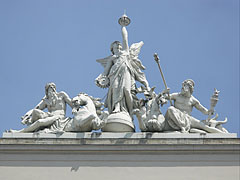 The allegorical statue on the top of the facade of the Keleti Railway Station
The allegorical statue on the top of the facade of the Keleti Railway Station
On the top of the front wall of the Keleti Railway Terminal at 43 meters high there is a sculpture group called "The allegory of the transportation". The composition represents the birth of the railway with a unique metaphor: between the gods of the fire and the water (in the ancient Roman mythology Vulcan and Nepune) a female figure symbolizes the birth of the steam.
The artwork needed to be completely recreated during the renovations of 1990, because the original tin plate statues were very ruined. Now the new statues were casted of aluminum alloy.
Considering the sculptor of the original statue from 1884 there is no clear consensus. Some sources say the maker was Gyula Bezerédi, others claim it was created by Ede Mayer and Béla Brestyánszky based on the idea and sketches of Leó Feszler (or Leo Fessler).
Budapest - Flere fotogallerier:
Du kan også være interessert i (Relaterte sider):
Destinasjoner i reiseguide:
Budapest (8 468 bilder + 21 panorama bilder)
Buda Hills (Budai-hegység) (8 632 bilder + 21 panorama bilder)
Pest megye (county) (15 122 bilder + 50 panorama bilder)
Budapest og dens omkringliggende (15 989 bilder + 52 panorama bilder)
Ungarn (27 287 bilder + 163 panorama bilder)
og i tillegg:
(innenfor her: Buda Hills)
Budakeszi (88 bilder)
Pilisszentiván (76 bilder)
Alle panoramabilde her:
Budapest (21 bilder)
Pest megye (county) (50 bilder)
Budapest og dens omkringliggende (52 bilder)
Ungarn (163 bilder)
Europa (165 bilder)
Hver normal bilde her:
Budapest (8 468 bilder / 122 gallerier)
Buda Hills (Budai-hegység) (8 632 bilder / 124 gallerier)
Pest megye (county) (15 122 bilder / 221 gallerier)
Budapest og dens omkringliggende (15 989 bilder / 234 gallerier)
Ungarn (27 287 bilder / 462 gallerier)
Europa (30 494 bilder / 523 gallerier)
https://www.panadea.com/no/guidebook/budapest/photos/gal-040

Legg til i Favoritter Legg til Bokmerker
Del med vennene dine!
osv.
Om oss - Generelle forbehold -
Alle rettigheter reservert
- ©2010-2022
Neuronit Creative Studio - Mogyoród / Budapest / Ungarn


